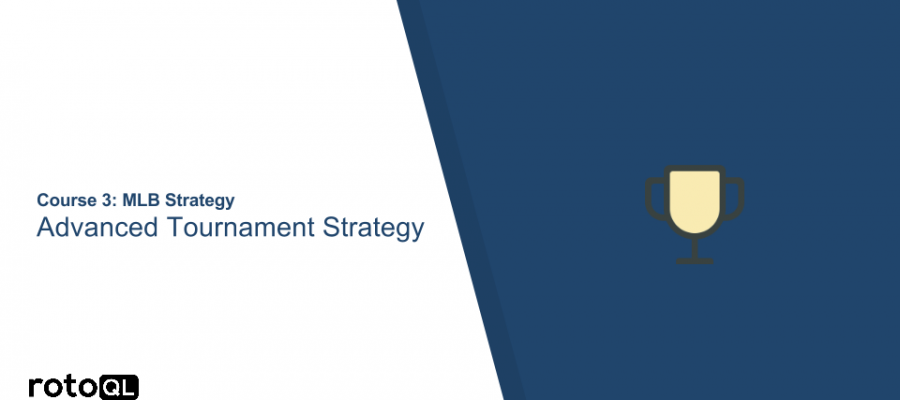Advice on How to Play Daily Fantasy Baseball GPP’s
Posted on August 23, 2016
Here at the RotoQL blog we have made it our mission to prepare our users with a DFS MLB lineup advice for the start of the season and beyond.
When playing Daily Fantasy Baseball, it’s important to build a strategy heading into the competition, especially when constructing lineups for MLB tournaments. Lucky for you, Saahil Sud, formerly Maxdalury, has already done this, creating a smart, strong strategy to serve as advice on how to play daily fantasy baseball GPP’s.
This strategy, based on Saahil’s MLB GPP strategy video, will cover pitcher selection, hitter selection, and lineup construction, and will touch on Vegas data, stacking, and player ownership within the context of constructing tournament lineups. The goal is create a lineup with a high ceiling.
Pitcher Selection
There are several key elements and stats to look at when picking the pitchers for your lineups.
Pitch Count and Innings Pitched
Possibly the most significant stat to look into before selecting the pitchers for your DFS lineup is pitch count and innings pitched. When playing in MLB tournaments, you need to have players that will put you apart from the other teams. Having a pitcher that can potentially go nine innings will do that. If a pitcher does go all nine innings, it will be tough to win the tournament if you don’t have that pitcher in your lineup. So it is important to target pitchers that normally go deep into games and can throw seven, eight, or even nine innings. The ideal pitcher you want to target is a guy that goes deep into games (at least seven innings) with a high strikeout rate.
Vegas Data
There are a couple of important things to research when looking into Vegas data. Obviously you want pitchers that will give up the fewest runs, so you must look at the opposing team’s expected runs. If Vegas thinks a pitcher is going to give up a high amount of runs, you might want to avoid selecting that pitcher. Another significant stat is win probability. If a pitcher’s team has a low win probability for that day, then they are not expected to win, and thus they should be avoided.
There are a few more Vegas stats that can help you with selecting your lineup. Team totals are important because they take into account many different variables, such as weather, park factors, etc. Player prop bets are also helpful. While they are not always exactly accurate, they do a good job of giving you a general estimate of how that player should do on that given night. Finally, the first five innings is important because it shows you how the starting pitcher is expected to do. Once you get past the first five innings, you start to enter the bullpen territory of the game, and thus the starting pitcher will start to have less effect on the game. The first five innings focuses solely on the starting pitcher.
w/OBA Against
Another element that you should check before selecting pitchers for your daily fantasy lineups is w/OBA Against. For those of you that do not know, w/OBA is the weighted on-base average. This statistic credits a hitter for the value of each outcome (single, double, triple, HR) rather than treating all hits or times on base equally. So your w/OBA will go up more after hitting a home run than it would for hitting a single. When choosing your pitchers, it is crucial that you look at w/OBA Against.
Strikeouts and Opponent Strikeouts per 9 innings
Of course, strikeouts reward you more points than a ground out or fly out, so ideally you want to pick pitchers that have high strikeout rates. While that might seem obvious, you must also look at the opposing team’s strikeouts per nine innings. If two pitchers have the same K/9, but one is facing a team with a higher strikeout rate than the other, then that pitcher is the one you want to roll with.
Ballpark and Weather Factors
The ballpark and weather conditions are another important factor when picking your pitchers. Obviously there are some parks that are known to be pitcher or hitter friendly (you don’t want to select a pitcher that is taking the mound at Coors Field that night), so be sure to do some research on the ballpark before you select your lineup. In addition, the weather can also play a big part in a player’s performance. If a stadium is dealing with massive gusts of winds, then that can have a big effect on fly balls, either carrying more than they normally would or not as far as they should have gone. You also want to stay as far away from rain as possible when it comes to picking your pitchers.
Hitter Selection
We talked about the pitchers, now it’s time to talk about strategy for selecting your hitters. In Saahil’s fka Maxdalury’s MLB GPP strategy video, he talks about the importance of several factors when choosing your hitters. The first is the Coors Field effect.
Coors Field Effect
It is no surprise that Coors Field has the highest run and home run rate of any stadium in Major League Baseball. Hitters playing at Coors Field will cost more than they normally would, due to the hitter-friendly conditions in Denver. Due to the city’s height above sea level, balls will travel farther in Coors Field than they would if they were hit exactly the same at any other ballpark. This gives an obvious advantage to hitters visiting the Rockies in Colorado. If you want to target a player that’s visiting Coors Field, you might want to pick a guy lower in the batting order, as it will cost you less but yet you still get to take advantage of the hitter-friendly ballpark.
Batting Order
The batting order is another key factor when researching which hitters to pick. The top spots in the batting order average more at bats per game than the lower spots in the batting order, and thus they have more opportunities to score fantasy points. That is why guys that tend to hit near the top of the batting order are always owned more than guys that hit further down in the batting order. You want your hitters to have as many chances as possible to score your team fantasy points, and the best way of doing that is to make sure they hit toward’s the top of their team’s batting order. The guys towards the top of the lineup are normally the team’s stronger hitters, and are normally better run producers. Ownership for these types of hitters are always high, so make sure to look at all factors before deciding on who to pick for your lineup.
There are a few other important elements to think about. A player’s home run ability is clearly an important factor. The higher a batter’s power is, the higher his ceiling will be. Home runs fetch you the most points of any type of hit, so of course you would like to have guys in your lineup that have the home run hitting ability. Handedness splits are also crucial to look into when considering which hitters to choose. You must look at matchup w/OBA to see how a player is truly hitting against right or left handed pitchers. If a right handed batter has a high w/OBA against right handed pitching, then that is a type of player you are going to want to have in your lineup as often as possible. If a player like Bryce Harper, a left handed hitter, is facing a weak lefty pitcher, that might be a player to target as Harper’s price should be lower than normal due to the lefty-lefty matchup.
Weather Conditions
While you should check the weather to ensure your hitters aren’t supposed to be playing in awful, storm like conditions that day, weather conditions are less of a concern when it comes to your hitters than with your pitchers. The ball flies further on days with higher temperatures and more humidity, so you might want to target ballparks that are playing in temperatures in the 90s, even in the 100s. Consider a ballpark like Pittsburgh, that tends to be pitcher-friendly. If the temperature heading into the game is very high, the ball is likely to travel further in this normally pitcher-friendly stadium, and thus could give you a slight advantage over those that do not know about balls traveling further in hotter and more humid conditions.
Vegas Data
Similar to the pitchers, there are some Vegas stats that could help you make an informed decision with your hitters. Team expected runs suggest the predicted number of runs scored for each team each night. So if a team is playing against a weak pitcher in a hitter-friendly park, their expected runs are going to be high. This sort of team is what you’re looking for if you want to stack a few players from one team in your lineup. The game’s over/under is also important, as it gives prediction on the number of runs that are expected to be scored that game, which gives you some insight on how they expect both the pitchers and hitters to perform. Finally similar to pitcher selection, you should look at player prop bets to see how hitters are expected to perform that night.
Lineup Construction
In the final section of this article, we are going to look at the crucial stats to look at before constructing your lineup. First up is salary distribution. You definitely want to be aware of how much money you are spending on hitters versus pitchers, especially when you have multiple MLB tournament lineups.
Salary Limits
In tournaments, while you still want to be targeting good pitchers, you should spend less on them than you would in cash games. In order to win a GPP, you need all of your players to score. So if you’re taking two stud pitchers and a few hitters that aren’t really going to put up any scores, then you are unlikely to win a GPP, even if both of your pitchers put up 40 points. So in tournaments, you are going to spend a little less on pitchers (but you still want to get some good pitchers, and should probably spend around 18K on them). You want to make sure that you don’t have too many zeroes in your lineup by taking better pitchers and thus losing talent with your hitters.
Going ‘Chalk’
Now let’s talk about daily fantasy baseball chalk player strategy. A chalk player is an “obvious” favorite that is highly owned and likely to perform well. Saahil provides a way to decide whether or not to start a chalk player in this MLB GPP strategy video. Think about what the chances are for this chalk player to be the best play at his position. If you think Clayton Kershaw is going to be the best play at starting pitcher 80% of the time he takes the mound, and his projected ownership is 60%, then you should play him. You want to make sure the chance the player has at being the best play is higher than his projected ownership. Chalk pitchers are more consistent than chalk hitters, so if you are going to target some chalk players, look for the stud pitchers. Lastly, while it is definitely fine to start some chalk players, you don’t want your whole lineup filled with them, especially in tournaments.
Predicting Ownership for Tournaments
The next topic is considered one of the “Holy Grail” topics of the DFS industry, and that is predicting daily fantasy ownership. There are several elements that help you predict whether a player will have a high or low ownership percentage. First we’ll look at high ownership percentage. Three things will help you predict a high ownership percentage for a player. The first is great recent performance. If a player is coming off a couple multi-hit games, including the day before where he hit a home run, then that player is going to have a higher ownership percentage. DFS users tend to ride the coattails of a player’s success, and when they see a great performance the day before, they want to repeat that success again the following day.
A great matchup will also lead to a higher ownership percentage. If a good pitcher is going up against a very weak lineup, then that pitcher’s ownership is going to be higher than normal. The same goes for good hitters facing off against below-average pitchers. The last thing that can lead to a high ownership percentage is a great value. If a player is being listed for cheap, even though he’s been hot lately or maybe has a good matchup, then more owners are going to select that player for their lineup. DFS users are always trying to find value picks.
Considering the three factors that lead to high ownership percentage, then obviously the opposites of those factors lead to low ownership percentages. A poor recent performance, let’s say 0-for-4 with four strikeouts (or the Golden Sombrero), will lead to less owners choosing that player for their lineup. A poor matchup, like a pitcher playing at Coors Field, will lead to a much lower ownership percentage for that pitcher. Finally poor value, or if a player is listed for more money than you think he’s worth, will lead to him being owned less that day. These are all factors you must look at before choosing your lineup.
Stacking
When it comes to stacking, you can’t overthink it. If there’s a four-player stack that you really like, go for it. Stack the maximum number of players you’re allowed (DraftKings allows up to five, FanDuel allows up to four). The important thing to remember is that you must differentiate yourself from all of the other teams. If you stack five players from a good offensive team, chances are others in the tournament have the same stack in their lineup. So even if that stack does well, you aren’t going to gain much on your competition.
You should also think about MLB value stack strategy to your lineup. Value stacks are stacks from teams with less heralded offenses. These tend to be teams that are off everyone’s radar, but if they come through for you, they end up being very valuable. One strategy Saahil recommends is including a value stack in your lineup, and inserting chalk players in the other slots. If your stack ends up performing well, and your chalk players don’t completely choke, then you will be in great shape. One thing that’s important to keep in mind when stacking your lineup is you must be mindful of how much of your team’s salary you’re spending on the stack. While having a strong stack is great for your lineup, it won’t help much if you have to fill the rest of your lineup with bottom of the order hitters. Make sure you’re still spreading your salary around to each position to ensure productivity out of each slot (don’t stack over half of your salary on five hitters).
Multiple Lineup in GPPs
The final thing we will discuss is the importance of having multiple lineups in a tournament. Obviously the more lineups you have in a tournament, the better your chances are of winning. Multiple lineups allow you to get exposure to many different types of situations, while reducing your variance. You must have a strategy on how you are going to attack things with your different lineup, such as what percentage of your teams are you going to stack, which chalk players you’re going to use in which lineups, etc.
Well there you have it. There is Saahil’s fka Maxdalury’s advice on how to play daily fantasy baseball GPP’s. If you follow this strategy, you are more likely to end near the top of your tournament standings. Make sure you do your research before choosing your lineups, and keep all of the factors listed above in mind.
With daily fantasy baseball season, start with using FanDuel and DraftKings MLB lineup optimizer from RotoQL to get an edge.




